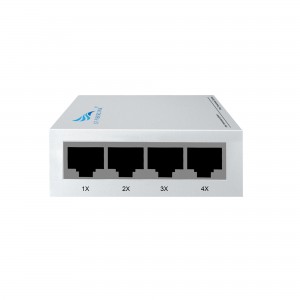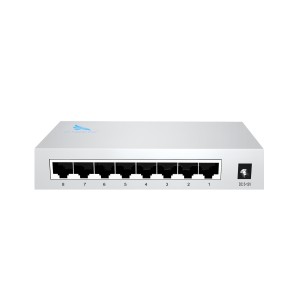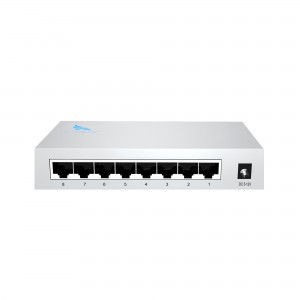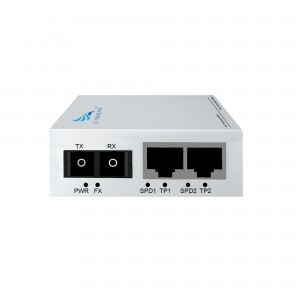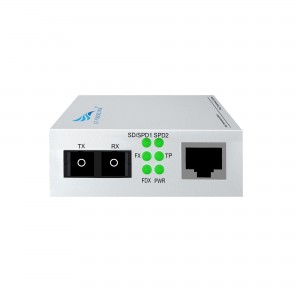2-port 10/100M WDM Media Converter (Single-mode Single-fiber SC)
2-port 10/100M WDM Media Converter (Single-mode Single-fiber SC)
Product Features:
Proudly presenting our latest innovative outdoor fiber optic transceiver – 1 optical 1 electrical single mode single fiber A end. Developed by Huizhou Changfei Optoelectronics Technology Co., Ltd., a leading and trustworthy manufacturer of industrial communication products and cloud-managed network products in China, this advanced optical-to-electrical converter is bound to revolutionize the world of optical fiber communication.
At Huizhou YOFC, we are committed to providing cutting-edge solutions to meet the growing needs of the telecommunications industry. Our wide range of products includes cloud-managed industrial switches, PoE switches, Ethernet switches, fiber optic transceivers and wireless transmission equipment. With years of expertise and a strong focus on research and development, we have earned a reputation for delivering high quality, reliable products that exceed our customers’ expectations.
1 optical 1 electrical single-mode single-fiber A end is designed to improve the efficiency and reliability of outdoor optical fiber networks. Its plug-and-play functionality ensures seamless integration, making it easy to install and use even by non-technical personnel. The iron casing design not only enhances its durability, but also provides effective heat dissipation to ensure peak performance even in harsh environments. Additionally, the IP30 rating ensures dust and water resistance, making it suitable for outdoor applications.
This fiber optic transceiver is manufactured using state-of-the-art technology, ensuring excellent performance and reliability. It supports single-mode single-fiber transmission, making it a cost-effective solution for long-distance communication. Equipped with advanced signal processing capabilities, it ensures stable, high-speed data transmission and eliminates any signal loss or degradation.
1 optical 1 electrical single-mode single-fiber A end is specially designed to meet the diverse needs of various industries. Whether used in telecommunications, security systems or industrial automation, the transceiver provides seamless connectivity and reliable performance. It can be easily connected to other fiber optic devices, such as switches or routers, providing a flexible and scalable solution for expanding network infrastructure.
We attach great importance to customer satisfaction, ensuring that our products undergo stringent quality tests and meet international standards. Our professional team is dedicated to providing timely technical support and assistance to ensure a smooth and hassle-free experience for our valued customers.
To sum up, Huizhou YOFC’s 1 optical, 1 electrical single-mode single-fiber A end is a game-changer for outdoor optical fiber transceivers. Its plug-and-play functionality, robust design, and high-performance features make it ideal for any fiber optic network. Trust our expertise and choose a reliable partner for all your communication needs. Experience seamless connectivity like never before!
What This Product Does
◇ CF-101SW-20A is a Hundred megabytes media converter, providing a Hundred megabytesRJ-45 port and a Hundred megabytes SC fiber port, which can convert between electrical and optical signals.
How This Product Works
◇ CF-101SW-20A adopts WDM (wavelength division multiplexing) technology, helping send and receive data at a distance of up to 20 km with only a single mode fiber, which saves half of the cable deployment cost for customers. CF-101SW-20A transmits data at 1310 nm wavelength and receives data at 1550 nm wavelength on optical fiber. Therefore, the terminal device used in conjunction with the CF-101SW-20A should send data at a wavelength of 1550 nm and receive data at a wavelength of 1310 nm. CF FIBERLINK another media converter CF-101SW-20B is one of the products that can cooperate with CF-101SW-20A.
Other Features
◇ Besides, this media converter can be used as a standalone device (no rack required) or used with CF FIBERLINK’s CF-2U14 rack for auto MDI/MDI-X in TX port in which duplex mode is automatically negotiated.
technical parameter:
|
Model |
CF-101SW-20A | |
| Interface Characteristics | ||
|
Fixed Port |
1* 10/ 100Base-TX RJ45 port 1* 155M uplink SC fiber port |
|
|
Ethernet Port |
10/ 100Base-TX auto-sensing, full/half duplex MDI/MDI-X self-adaption |
|
|
Twisted Pair Transmission |
10BASE-T: Cat3,4,5 UTP(≤100 meter) 100BASE-T: Cat5e or later UTP(≤100 meter) |
|
| Optical Port | Default optical module is single-mode single-fiber 20km, SC port | |
| Wavelength/Distance | A-end: RX1310nm / RX1550nm 0 ~ 40KM
B-end:RX1550nm/ RX1310nm 0 ~ 40KM |
|
| A-end: RX1490nm / RX1550nm 0 ~ 120KM
B-end:RX1550nm/ RX1490nm 0 ~ 120KM |
||
| Chip Parameter | ||
| Network Protocol | IEEE802.3 10BASE-T, IEEE802.3i 10Base-T,
IEEE802.3u 100Base-TX, IEEE802.3u 100Base-FX, IEEE802.3x |
|
|
Forwarding Mode |
Store and Forward(Full Wire Speed) |
|
|
Switching Capacity |
0.4Gbps |
|
|
Buffer Memory |
0.3Mpps | |
|
MAC |
1K | |
|
LED Indicator |
Fiber | FX(green) |
| rate | SD/SPD1 (green)
SPD2: 10/ 100 (green) |
|
| Data | TP (green) | |
| FDX (green) | ||
| Single / duplex | ||
| Power | PWR (green) | |
| Power | ||
| Working Voltage |
AC:100-240V |
|
|
Power Consumption |
Standby<1W, Full load<3W |
|
|
Power Supply |
DC:5V/2A industrial power supply |
|
| Lightning protection &Certification | ||
| Lightning protection | Lightning protection: 4KV 8/20us, Protection level: IP30 | |
| Certification | CCC;CE mark, commercial; CE/LVD EN60950;FCC Part 15 Class B; RoHS | |
| Physical Parameter | ||
| Operation TEMP | -20~+55°C;5%~90% RH Non condensing | |
| Storage TEMP |
-40~+85°C;5%~95% RH Non condensing |
|
| Dimension (L*W*H) | 94mm* 71mm*27mm | |
| Installation | Desktop, CF-2U14 slot rack | |
Product Size:
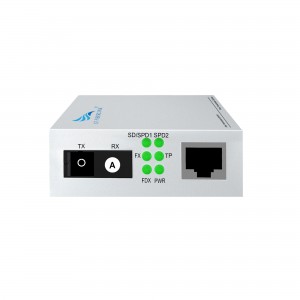
Product application diagra:

How to choose a fiber optic transceiver?
Optical fiber transceivers break the 100-meter limitation of Ethernet cables in data transmission. Relying on high-performance switching chips and large-capacity caches, while truly achieving non-blocking transmission and switching performance, they also provide balanced traffic, isolation and conflict. Error detection and other functions ensure high security and stability during data transmission. Therefore, fiber optic transceiver products will still be an indispensable part of actual network construction for a long time. So, how should we choose fiber optic transceivers?
1. Port function test
Mainly test whether each port can work normally in the duplex state of 10Mbps, 100Mbps and half-duplex state. At the same time, it should be tested whether each port can automatically select the highest transmission speed and automatically match the transmission rate of other devices. This test can be included in other tests.
2. Compatibility test
It mainly tests the connection ability between the optical fiber transceiver and other devices compatible with Ethernet and Fast Ethernet (including network card, HUB, Switch, optical network card, and optical switch). The requirement must be able to support the connection of compatible products.
3. Cable connection characteristics
Test the fiber optic transceiver’s ability to support network cables. First, test the connection ability of Category 5 network cables with lengths of 100m and 10m, and test the connection ability of long Category 5 network cables (120m) of different brands. During the test, the optical port of the transceiver is required to have a connection capability of 10Mbps and a rate of 100Mbps, and the highest must be able to connect to a full-duplex 100Mbps without transmission errors. Category 3 twisted pair cables may not be tested. Subtests can be included in other tests.
4. Transmission characteristics (transmission loss rate of data packets of different lengths, transmission speed)
It mainly tests the packet loss rate when the optical fiber transceiver optical port transmits different data packets, and the connection speed under different connection rates. For the packet loss rate, you can use the test software provided by the network card to test the packet loss rate when the packet size is 64, 512, 1518, 128 (optional) and 1000 (optional) bytes under different connection rates. , the number of packet errors, the number of packets sent and received must be more than 2,000,000. Test transmission speed can use perform3, ping and other software.
5. The compatibility of the whole machine to the transmission network protocol
It mainly tests the compatibility of fiber optic transceivers to network protocols, which can be tested in Novell, Windows and other environments. The following low-level network protocols such as TCP/IP, IPX, NETBIOS, DHCP, etc. must be tested, and the protocols that need to be broadcast must be tested. Optical transceivers are required to support these protocols (VLAN, QOS, COS, etc.).
6. Indicator status test
Test whether the status of the indicator light is consistent with the description of the panel and the user manual, and whether it is consistent with the current status of the fiber optic transceiver.








